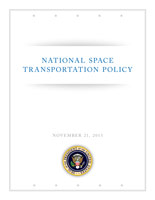National Space Transportation Policy
On November 21, 2013, President Obama issued an updated National Space Transportation Policy providing guidance to federal departments and agencies on the development and use of commercial and governmental space transportation systems.
The overarching goal of the policy is to have assured access to diverse regions of space, from suborbital to Earth’s orbit and deep space, in support of civil and national security missions.
To further this goal, the policy prescribes actions aimed at improving U.S. launch industry robustness, cost effectiveness, innovation, entrepreneurship, and international competitiveness.
Commercial Space Guidelines
The National Space Transportation Policy includes guidance applicable to the civil, national security, and commercial space transportation sectors. The commercial space section reiterates the pro-business direction issued in the National Space Policy and adds new guidance to federal agencies, including:
- Facilitate multiple U.S. commercial providers of space transportation services across a range of launch vehicle classes;
- Maximize availability of government space transportation technologies, capabilities, and facilities for non-federal use on a reimbursable, noninterference, equitable, and predictable basis;
- Cultivate increased technological innovation and entrepreneurship through incentives such as nontraditional acquisition arrangements, competition, and prizes;
- Encourage the purchase and use of U.S. commercial space transportation services and capabilities in international trade and cooperative government activities;
- Facilitate U.S. commercial industry access to available public data and lessons learned related to human space flight; and
- Pursue policy, regulatory, and other measures to foster the development of U.S. commercial spaceflight capabilities serving the emerging commercial human spaceflight market.
The policy directs the Departments of Commerce and Transportation to encourage, facilitate, and promote U.S. commercial space transportation activities, including human spaceflight.
Commercial Human Spaceflight
The National Space Transportation Policy recognizes the significance of commercial human spaceflight activity, adding two goal statements in this area. It codifies NASA’s ongoing commercial crew and cargo program, which is establishing a competitive domestic market for transport to and from the International Space Station.
In addition to the relevant commercial guidelines cited above, the policy directs FAA to work with NASA on a comprehensive safety regime for human spaceflight, covering both governmental and commercial activities with minimal regulatory overlap.
Hosted Payload Arrangements
The National Space Transportation Policy recognizes the growing opportunities to fly government missions as hosted payloads on commercial satellites. It directs federal agencies to actively explore hosted payloads and other ride-sharing arrangements when planning space missions.
The policy facilitates the government’s utilization of hosted payloads by providing departments and agencies additional discretionary authorities to consider launches on non-U.S.-manufactured space launch vehicles.
Industrial Base
The policy directs agencies to consider the health of the space transportation industrial base when making policy and programmatic decisions. It encourages innovative acquisition approaches that promote affordability, industry planning, and competitive capabilities, infrastructure, and workforce.
The policy directs NASA and the Department of Defense to rely upon U.S.-manufactured space transportation vehicles as the foundation for access to space. It encourages unique acquisition approaches, which will promote competition, stabilize supply chains, and realize economies of scale.
New Entrant Certification
The policy codifies the plan to enable new U.S. commercial space launch providers to compete for U.S. government missions on a level playing field so long as they meet technical criteria for certification.
Launch Ranges
The policy directs enhancements to the operational efficiency, capacity, responsiveness, and cost effectiveness of federal space launch infrastructure. It calls for consultations with industry to seek to improve launch range scheduling procedures and practices. The updated text also recognizes the need to work with commercial, state, and local spaceports.
Orbital Debris
The policy declares that the Department of Transportation has exclusive authority to address orbital debris mitigation practices for U.S.-licensed commercial launches.
Excess Ballistic Missiles
The 2013 policy reaffirms longstanding guidance and laws on the use of excess intercontinental ballistic missiles (ICBMs) as launch vehicles. The New START Treaty for nuclear disarmanent allows the use of excess ICBMs as satellite launchers, but the United States restricts such use so as to minimize competitive impacts on U.S. commercial firms with comparable launch capabilities.
National Space Policy
Released in 2020, the National Space Policy also provides guidance on assured access to space. The policy directs U.S. agencies to:
- Work collaboratively to acquire space launch services and hosted Government payload arrangements that are secure, reliable, cost-effective, and responsive to U.S. Government needs;
- Enhance operational efficiency, increase capacity, and reduce launch costs by investing in the modernization of space launch infrastructure;
- Permit the launch of U.S. Government spacecraft manufactured in the United States from territories of allied and likeminded nations when launched on vehicles manufactured in the United States; and
- When sufficient U.S. commercial capabilities and services do not exist, support industry-led efforts to rapidly develop new and modernized launch systems and technologies necessary to assure and to sustain future reliable, resilient, and efficient access to space.
The policy also directs NASA to continue as the launch agent for the civil space sector while utilizing commercial space capabilities and services to the maximum practical extent, and to grow partnerships with the commercial space sector to enable safe, reliable, and cost-effective transport of crew and cargo to destinations in low Earth and cislunar orbits, and to the lunar surface.
